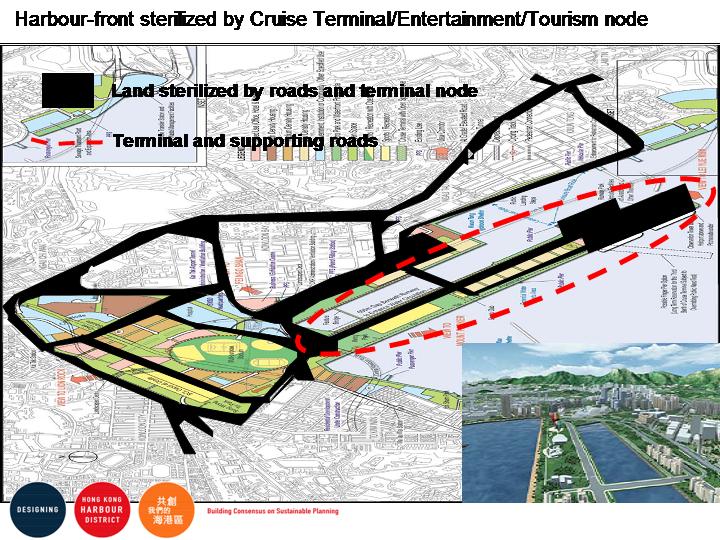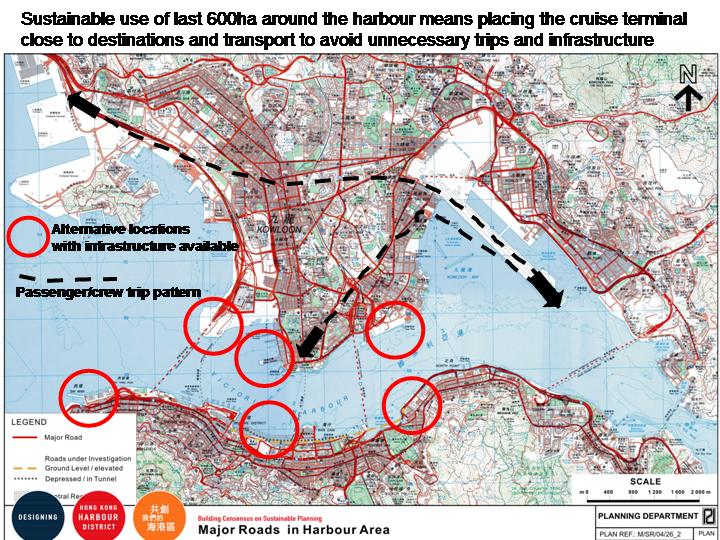
To make the best use of Hong Kong's harbour, we not only need to upgrade facilities for cruise liners but for many other marine uses. From shelter to moorings, berthing, storage, repairs, ship shops, club houses, passenger handling and loading/unloading, we need facilities for tug boats, harbour cruises, fishing boats, China cruises, yachts, ferries, dragon boats, rowing, refuse transfer, sailing boats, water taxis, sea planes, and so forth.
Although the Government has yet to commence a 'Living Harbour Review' defining these requirements for Victoria Harbour, Kai Tak with its long coast line and sheltered waters appears to be a natural nautical centre. However, t he narrow Kai Tak runway, lacking transport infrastructure and the distance to tourist destinations, may NOT be the most suitable location for a cruise terminal.
With only 600 hectares of land left around Victoria Harbour (West Kowloon, Hung Hom, Kai Tak, North Point Estate, Oil Street, Tamar, Central Reclamation, and a few sites in Sheung Wan and Kennedy Town) sustainable decisions of 'what should go where' must be based on a clear cost/benefit analyses.
A summary analyses indicates that Kai Tak is very expensive compared to West Kowloon.
Land cost: Additional land is required for hotels, entertainment, retail and new roads to make a cruise terminal viable in Kai Tak. However, these are already available close to West Kowloon, including the highway, KCRC, MTR, Airport Railway, hotels, entertainment and cultural facilities. Placing cruise terminals in West Kowloon would leave enough land for the proposed new cultural facilities.
Infrastructure cost: Placing the cruise terminal and supporting uses in Kai Tak requires the construction of new transport infrastructure. With Tsimshatsui and the airport as key destinations, it also creates additional vehicular movements on some of Hong Kong's most crowded roads increasing congestion and economic losses. In West Kowloon, the existing infrastructure has sufficient over-capacity to handle the surge traffic caused by cruises in town at the same time. Tsimshatsui, Central, Chep Lap Kok and cross border destinations are all within easy reach.
Environmental cost: The cruise terminal, and the new roads required to service the terminal, will sterilize a major part of the Kai Tak runway and segregate the community from the harbour-front. All recent harbour planning surveys show that the community wants access to the harbour and ample space for active public use. Placing the cruise terminal in West Kowloon will free up 3 kilometers of harbour-front for alternative harbour orientated uses.
Opportunity cost: With cruise terminals and supporting roads in Kai Tak we forego the opportunity of zoning the land to support marine users, and create related jobs, which are hard to support elsewhere. It is relatively easy to move the break waters around Kai Tak to create more typhoon and marina shelter for smaller crafts. The frequent daily movements of these vessels would create few conflicts with existing marine traffic. However, waters off West Kowloon are busy with ferry routes and other commercial users and are better suited for cruises which create only a few movements every week. Further, any new break waters in West Kowloon would create unacceptable obstruction to marine traffic.
Dredging cost: To cater for cruise ships dredging would be required equally in Kai Tak and West Kowloon. (Only Hung Hom can be used without dredging.)
Reclamation cost: Both in Kai Tak and West Kowloon, reclamation would be required to create piers. Piers would enable a more efficient land use then berthing alongside a quay. As piling for piers is considered reclamation, an overriding public need must be established. However, as piers add value by increasing the use of the harbour rather than destroying the harbour with the formation of land, this may well be easier.
Conclusion: With only 600 hectares of land left around Victoria Harbour and a long wish list of competing land uses, we require a sustainable distribution of facilities along the harbour-front. We need to identify which facilities we place where to generate the greatest benefits at the lowest economic, social and environmental cost. This does not only apply to marine facilities, but likewise to cultural facilities, where a harbour-wide review will demonstrate that off-peak time traffic drivers are best placed in Central and Wanchai given the lack of land for new transport infrastructure in the area. To determine the best location based on the private sector responding to calls for tenders may give some insight, but that does not lead to sustainable solutions. We first need to give the private sector a clear indication of what we need and where! That is, if we can find someone in Government to take responsibility for this.
Given the other alternatives, there is no justification for the location of the Cruise Terminal in Kai Tak.

